I have written several times about the art of Daniel Mitsui.
For Mr. Mitsui’s site click HERE.
He has sent me a few more things, this time from a series of drawings for the Holy See’s Vox Clara Committee (the translation liaison with the Congregation for Divine Worship) for use as illustrations in the interim edition of the Roman Pontifical.
The originals, he informs me, were in colored calligraphy on Bristol board in a style influenced by 15th century panel paintings, tapestries and incunabula from N. Europe.
Here is a view of the Pentecost scene.
A detail. I am using my iPhone.
St. Augustine is at the top right.
The Last Supper. You see the words Hoc est enim corpus meum in the corners and there are prefigures on the edges.
There is so much going on and each element is well thought out and well attested in the history of art.
Judas doesn’t get a halo, but he has his bag of money.
The wise virgins seems squared away. They have nice bright lamps and are properly dressed for the wedding banquet and the Bridegroom. There is nice angel with them.
The foolish virgins… not so much. No flames, poorly dressed. They get a creepy devil and some large critter which looks quite willing to chomp on them.
This is what I imagine the LCWR Assembly is like.
Christ the High Priest seems appropriate for today!
A detail of the Lord’s feet. Notice the elements on the globe. Subtle. Very cool.
I think we could have a little discussion about what all that means.
I am shooting through the plastic cover, btw.
The Presentation.
The Crucifixion.
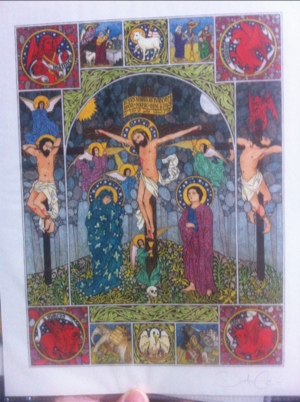
They are all 8.5″ x 11″ color glicee prints using pigmented inks on acid-free rag paper.
He is selling them for $80 each or $320 for the set of five, plus shipping.
The print of Christ the Priest would be an EXCELLENT gift to a newly ordained priest or to a priest or bishop for his Jubilee.
The Presentation would be a nice gift to a woman religious.
I am sure you could find other occasions or reasons. For example, someone interested in the charismatic movement might like Pentecost. The Crucifixion would be good as a private devotional picture in a place where you habitually pray. The Last Supper would be good on the wall of a dining room in a family home. Individual prints or a set could be donated to a parish for an auction.
Think of your own!
Mr. Mitsui’s site is HERE.

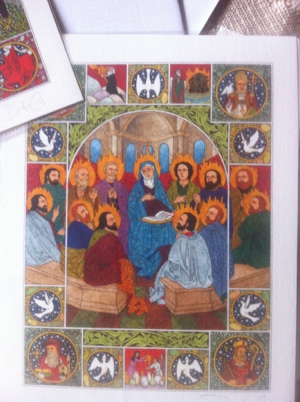

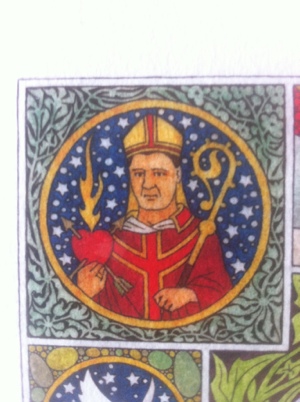
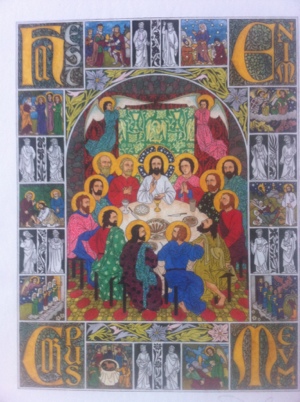
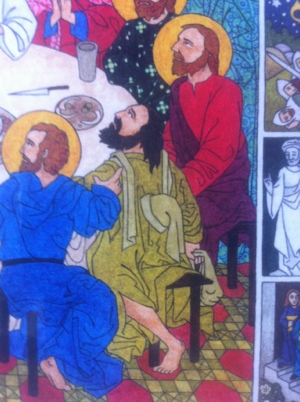
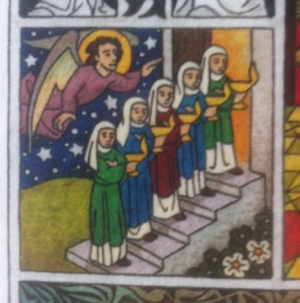
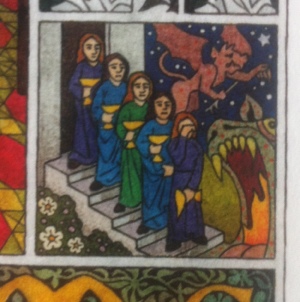
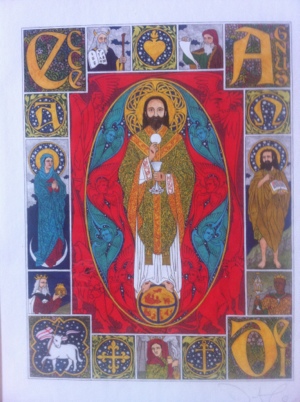
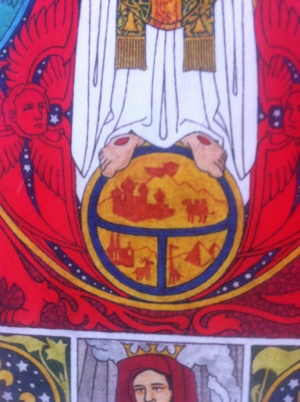
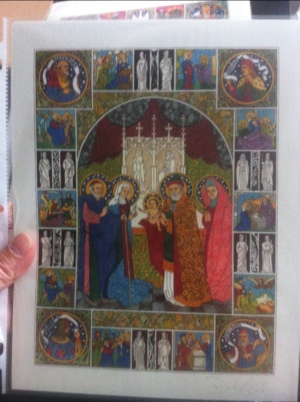

































These are lovely, but my son wants a dog when he is ordained.
What is depicted on the lower left hand side of the globe?
Supertradmum,
What a wonderful son you have!
Thank you Fr. Z for drawing attention to this fabulous artist. I bought his print on the Four Last Things and it is beautiful and perennial in design. His style is both modern and ancient. I love it!
These are indeed beautiful! I hope that Christ the High Priest’s maniple is merely hidden beneath his chasuble!
The globe is great! It is modeled on a medieval T-map that places the then known world into a very different orientation that moderns are accustomed. Asia is at the top of the map; Europe to the lower left; and Africa to the lower right. In these medieval maps, Jerusalem is at the center of the map. Awesome stuff!
Supertradmum,
What sort of dog?
Mr. Mitsui just goes from strength to strength.
De gustibus and all that – but in my opinion they are ugly and I wouldn’t want any of them as a gift. Supertradmum – A dog for an ordination present – really bad idea. A priest needs to be free to travel wherever he is asked to for the sake of the Gospel – what if he were asked two months after ordination to go to Rome to study? What if his first appointment is with a pastor who hates dogs, cats, goldfish? What if he is assigned to the Cathedral where there may be any number of other residents, who may not like the idea of a dog moving in? The dog would very quickly become someone else’s responsibility. Instead of a dog, buy him a good supply of dog collars!
I was looking at the globe that Our Lord is standing on, but I got a different impression of what I was looking at. Of course, I was ignorant of the background of this sort of medieval T-map in art before I read “Liam’s” comment. To my untrained eye, it looked to me as though the three sections of the globe represent the three major Abrahamic religions. I thought the mosques in the top left of the globe represent Islam, the pyramids represent the Jewish tribes during their exile in Egypt, and the Church represents Christianity. So I took it to mean the Jesus is standing on this globe to show that He is King of Kings and Lord of Lords for all.
This artwork is very beautiful! I like it much better than some of the original iconography that I’ve seen. Some of the face detail in the ancient iconography makes people like Our Lord and Our Lady look frightening. But Mr. Mitsui’s work is very easy to appreciate.
These are beautiful! I like the close-ups of the different details.
Very, very nice, indeed. They certainly would make wonderful gifts!
The large critter willing to chomp is actually the gates of hell.
As a man about to be ordained, Father, I must disagree.
Art is a very peticular taste, and I would discourage anyone from giving someone a work of art as a gift. If the newly ordained doesn’t particularly care for it, and you are a close friend, he may be put in the uncomfortable position of either telling you, “Thanks, but no thanks”, or worse, suffering through the display of something he doesn’t like.
I would suggest that people consult with theman to be ordained before buying anything, gifts, while well meaning, can be a burden if they are contrary to a person’s tastes or sensibilities.
(A very thoughtful woman has given me a wooden chalice. She certainly meant well, and I can use it as a decoration, but I think she expects me to use it at Mass, which I could never do, even though it seems to have a gold lined bowl. Please, ladies and gentlemen, consult the individual to be ordained before buying art, vestments or Sacred vessels.)
FatherK,
It depends a lot on the dog – and the owner. Some (well bred and properly trained) dogs are virtually ‘invisible’. Others, not so much. Even within the same breed. I can take my oldest Labrador Retriever anywhere, she is small, silent as a fish, and stays close as a shadow. Most people never know she is there. My middle Lab . . . . not so much. She earned her sobriquet “Psycho Ruby”.
beez,
It’s a widespread problem — similar issues arise with wedding gifts, like remembering to take the hideous epergne given to you by your Aunt Minnie out of the attic before she comes to visit.
With artwork, you can always hang it in the spare bedroom (remember that scene in C.S. Lewis’s Dawn Treader where Harold and Alberta had put the painting of the Dawn Treader in the spare bedroom because it was a wedding present from someone they didn’t want to offend?)
AnAmerican Mother
No, it really depends on the person – some people just don’t like dogs, pets, animals, period. Then again I know of any number of priests who have a violent reaction to the mere sight of a dog collar!
In the residence where I live f0r the duration of my studies one of the staff members really has a thing about cats. If a cat were to venture into our building which is quite large – you wouldn’t see her for dust and she wouldn’t come back until the moggy had been removed! Really, I am not exaggerating. I believe King Henry II of England would faint at the sight of a cat.
It’s variously Henri III of France or Henry III of England, depending on which 2nd or 3rd hand source you read on line. Henry II just didn’t like archbishops.
So Mr. Boswell: “I am, unluckily, one of those who have an antipathy to a cat, so that I am uneasy when in the room with one; and I own, I frequently suffered a good deal from the presence of this same Hodge.” Oliver Goldsmith didn’t like them either.
I don’t think that level of revulsion is all that common — but maybe that’s because I have always had animals, so those sort of people have been avoiding me from the beginning.
Art criticism is a tricky thing: one is bound to upset the artist and offend the fans. I would try to avoid both the laudatory promotion and outright condemnation.
Over the years it has been interesting seeing Daniel Mitsui to venture beyond the earlier black-and-white calligraphy, into a world of color, figuration and human emotions. This threefold transition, I would argue, has been very dramatic for the art in question. Maybe more dramatic than the drama within the pictures. As his art started tackling religious themes, his compositions necessarily became more ambitious and the appearance of color and more complex emotions of the protagonists was almost expected. Seemingly immobile objects of earlier still lives, creatures of flora and fauna, and Medieval calligraphic lettering have given way to human protagonists of sacred drama. Nevertheless all the earlier preoccupations remained, permeating the compositions. The human and divine of Mitsui’s art dwell in horror vacui. The expected emotions are superimposed on the figures that are not able to break out of the vegetation and proliferation of details. Religious art as any other art is successful not only when it is iconographically (in Panofsky’s terminology) correct but when it moves, when it is inspired. It is hard to be touched by a rather emotionless face of St. Augustine. Yet it is the floral border around him that shows love, inspiration and the artist’s “full-blown” imagination! The same is true across many other pictures. The controlled stiff lines constraining figures give way to intellectual play of the ornament, akin to the effect of Bach’s fugues. I suspect that it is in these flights of inspiration that Misui’s art goes beyond its own drawbacks. However, diligent work always brings forth the fruits, and what we see is only the beginning.
We have to remember that by purchasing the artist’s work we don’t just get a product, we become active participants in the artist’s personal and artistic growth. The acquisition of his or her particular artwork also means an investment in the artworks to come.
Does he do stained glass? Because this is what we need in our parish architecture.
Anchorite,
I agree that it’s a matter of opinion — on two levels: both whether you like the general style of an artist’s work, and also whether you believe that he has done a good job within the parameters of that style. (I periodically get some people aggravated with me because, although I like the Pre-Raphaelites generally, I dislike Rossetti’s paintings because in many cases I don’t believe he technically achieved what he set out to do.)
I think you correctly observe that the style here requires constraint in the figures and exuberance in the ornament – Bach is a good example, also the vocal restraint required in a good cantor of Psalms who must submerge his or her musical “style” in favor of the required straight and emotionless delivery.
I see more emotional variation in the Pentecost figures, not only in facial features but in gestures. But that – within limits – is appropriate to the style. Remember how people used to sit for photographs in their “Sunday best” and look very solemn and serious. Portraiture was an event and had lasting consequences.
… which gives us opportunity to mention how Mr. Mitsui does a wonderful job with a Japanese woodcut-style OLPH, St. Michael and St. Raphael.
Ubiquitious,
I was about to mention that but got down a different rabbit hole — my daughter loves ukiyo-e woodblocks. I wish that St. Michael were available as a print because I would get one for her immediately – St. Raphael is lovely too, but the torsion and swirling movement in the Kuniyoshi style is something that I have always admired.
Beautiful artwork and so rich with things to think about. One detail which I enjoyed is that the five wise virgins are in habits with their heads veiled while the foolish women have their heads uncovered. Traditional vs conciliar sisters?
I was told when doing British history way back in primary school it was Henry II; that was in the days when we read history books and had reliable teachers – no Google [or internet for that matter]. So I will continue to believe it was Henry II in deference to Mrs Paris [RIP].
Whether the person your are in residence with loves or loaths pets, a pet is an encumberence for a priest, an unneccesary attachment and expense.
Re: foolish virgins, I’m pretty sure the uncovered hair is a way of showing that they’re distraught and not well put together (ie, secular women didn’t go outside or to events without their hat or headcovering, same as men didn’t go out without their hats or caps or what have you).
Re: gates of hell critter — technically, that’s the Hellmouth. As heard about on Buffy.
AnAmericanMother: You should e-mail him, see what he can do for you.
danmitsui [at] hotmail
These are just gorgeous works! Love the style and colors.
Some things I would add to Liam’s remarks – The circle around the earth are the oceans an the “T” are various seas and rivers. The left one is the Tanais (Don) River, the middle is the Mediterranean Sea and the right is the Red Sea. Liam is correct in that the center of the map is Jerusalem, but also at the top of the map is “Paradise” or the “Lost Garden of Eden” which was in Asia. It was always shown as separate, or cut off from the world.
Last weekend, I was thumbing through the new pontificale, which as you mention, he created the art for, and I was blown away. It’s a gorgeous book, and his art is absolutely wonderful. By the way, it looks 100 times better printed in a liturgical book than just looking at it on a screen.
“The foolish virgins… not so much. No flames, poorly dressed. They get a creepy devil and some large critter which looks quite willing to chomp on them.
This is what I imagine the LCWR Assembly is like.”
Well said, Father. The virgins who are ready for the Bridegroom look like habit wearing orthodox nuns who love Christ and His Church. The unprepared virgins, as you imply, resemble the heterodox sisters who whine and moan about the Church’s teachings and those mean ol’ bishops.
I would love to see these in person. I think they are lovely, like illuminated manuscripts, yes?
How nice to see art that says something beautiful. When I think of what passes for art these days, and the NEA using our tax dollars to subsidize it, I get annoyed. This is art I could support. Too many artists today think the only art is being offensive. We have always had art colonies in our area, and recently the graduates were told by their commencement speaker to “go out of your comfort zone”. In other words, be edgy. Confront. Challenge. Where are the works that bring something to contemplate? Something beautiful. Matsui has taken that on, and I like his results thus far.
Sometimes too, a gift that is given is a reminder of the giver, as well as being enjoyed for itself. I have gifts I love because I love the person who gave it. They selected it for me. There is always too, the idea that something beautiful can be passed along to someone else, and be a blessing for them. Sometimes it seems religious art or items are that way, they seem to end up at times where they were “meant” to be.
“gates of hell critter — technically, that’s the Hellmouth”
Thanks!
SO BEAUTIFUL! Oh what a lovely artist!
AnAmericanMom, a Westie